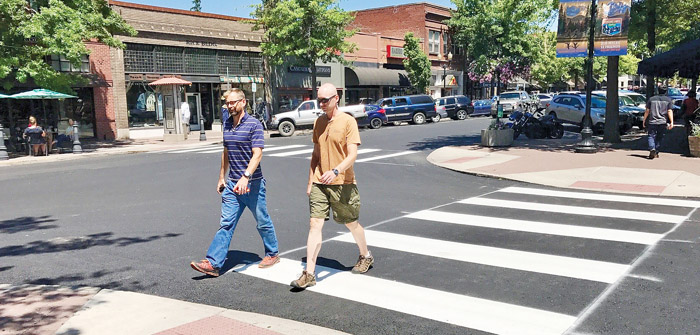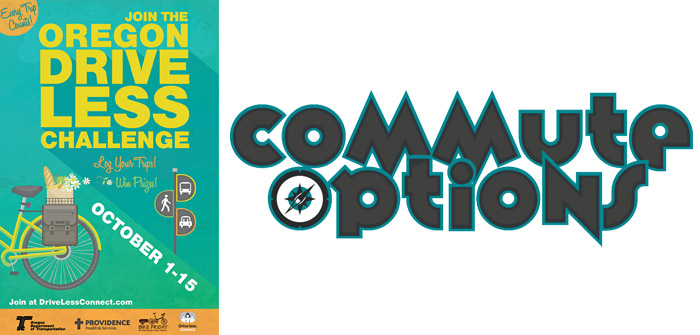By now, most of Bend’s residents know how to navigate into, around, and out of a traffic roundabout. Roundabout art has been applauded, criticized, voted on, mimicked, and is now part of the urban landscape. But as more roundabouts are planned for around Central Oregon, it may be helpful to remember why so many of these circular intersections were built in the first place.
Modern roundabouts are just circular intersections where drivers travel counterclockwise around a center island. With no traffic signals or stop signs, roundabouts are simply an alternative to signaled intersections. Drivers yield at entry to traffic in the roundabout then enter the intersection and exit at their desired street, all without stopping the flow of traffic.
The primary benefit of roundabouts is their safety record. Roundabouts have been shown to reduce injury crashes by 75 percent at intersections where stop signs or signals were previously used for traffic control, according to a study by the Insurance Institute for Highway Safety (IIHS).
Not only are there fewer accidents at intersections with roundabouts, but there have been no fatalities at roundabouts in Bend, said Robin Lewis, transportation engineer for the City of Bend. “Knocking fatalities out of the equation is really a big deal,” said Lewis.
A few intrinsic properties of roundabouts create safer conditions for all travelers moving through the intersection. For one, speeds are slower – typically between 15 and 20 miles per hour – at roundabouts because drivers must slow to yield to traffic before entering a roundabout. The few collisions that occur in roundabouts are typically minor and cause few injuries since they occur at such low speeds.
At roundabouts, there is also no light to beat; they are designed to promote a continuous, circular flow of traffic. Because traffic is constantly flowing through the intersection, drivers don’t have the incentive to speed up to try and “beat the light,” like they might at a traditional intersection.
And the severity of any crashes that do occur is usually mitigated because vehicles are all traveling one way. Roads entering a roundabout are gently curved to direct drivers into the intersection and help them travel counterclockwise around the roundabout. This one-way travel eliminates the possibility for T-bone and head-on collisions.
“If we are currently having T-bone crashes at an intersection, adding a traffic signal will not eliminate that,” said Lewis. Instead, the City of Bend’s solution is to build roundabouts at these dangerous intersections.
Driver safety is just one part of the equation. “Roundabouts accommodate more modes with less delay and queuing than comparable traffic lights,” said Lewis. Because traffic only approaches from one direction, it simplifies decision making for pedestrians crossing and bicycles merging with vehicles at roundabouts. “It really simplifies pedestrian operations,” said Lewis.
Roundabouts also keep traffic flowing better than signaled intersections. Eliminating stop-and-go traffic helps lower greenhouse gas emissions and helps drivers waste less fuel.
A roundabout is also less expensive over time than a signaled intersection because although building costs are comparable, maintenance and electrical costs associated with traffic signals are nonexistent at roundabouts. And without reliance on electricity, roundabouts operate during power outages.
Still, finding ways to include roundabouts on state highways like US 20 – a federally designated freight route – remains a challenge for governmental agencies and their engineers. The City of Sisters, with US 20 running through it, has a need for either signaled intersections or roundabouts at two of their most heavily-used intersections that will allow for safe turns by all vehicles, including oversized freight trucks.
“The most compelling and persuasive argument is for a roundabout,” said Lon Kellstrom, Sisters Mayor. The public appears to agree; ninety percent of those who filled out surveys after the November 16 community meeting agreed that a roundabout would be the best solution, citing safety, air quality, aesthetics, and smoothly flowing traffic as benefits.
Formalizing roundabout design to accommodate all modes is an ongoing process, said Lewis. “We have formalized standards with an eye towards not only freight movement accommodations, but also emergency vehicle circulation.”
With so many enthusiasts and a proven track record for safety, Central Oregon will no doubt be seeing more roundabouts on both its city streets and highways.
Commute Options promotes choices that reduce the impacts of driving alone. For more information about Commute Options, contact Jeff Monson, Executive Director of Commute Options at 541-330-2647 or visit www.commuteoptions.org.
Annissa Anderson is a freelance writer and PR consultant in Bend.




